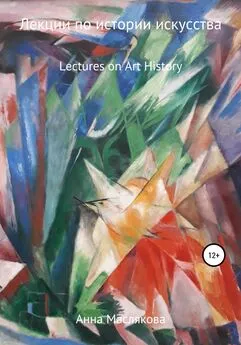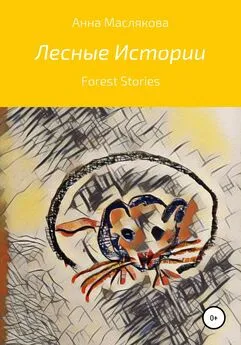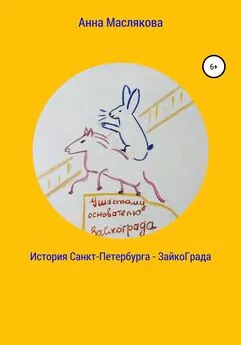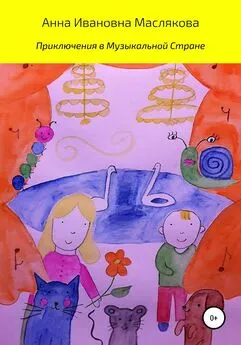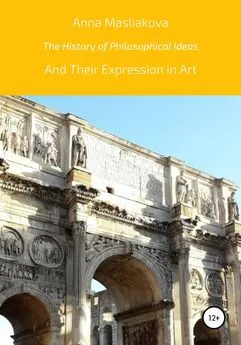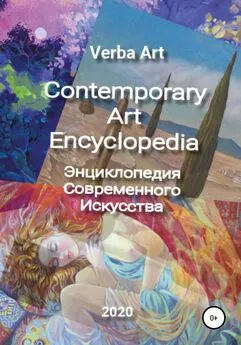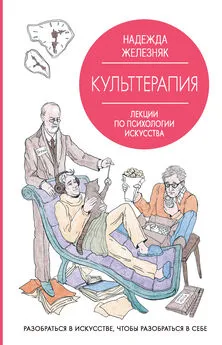Анна Маслякова - Лекции по Истории Искусства. Lectures on Art History
- Название:Лекции по Истории Искусства. Lectures on Art History
- Автор:
- Жанр:
- Издательство:неизвестно
- Год:2022
- ISBN:нет данных
- Рейтинг:
- Избранное:Добавить в избранное
-
Отзывы:
-
Ваша оценка:
Анна Маслякова - Лекции по Истории Искусства. Lectures on Art History краткое содержание
Лекции по Истории Искусства. Lectures on Art History - читать онлайн бесплатно ознакомительный отрывок
Интервал:
Закладка:
Анна Маслякова
Лекции по Истории Искусства. Lectures on Art History
Introduction
This book is the product of years of research executed by the author in the field of Art history. Each of the lectures reveals various aspects of the issue mentioned above, in particular, the influence of Antiquity on the formation of the aesthetic preferences of artists, the role of the Bauhaus in the development of Modern architecture, the interaction between Art and Nature, the symbolism of a mirror in the context of the Baroque era, as well as the importance of restauration and preservation of the Artworks. The narrative is supplemented by the photographs taken by the author during her trips around Russia and Europe. The book is dedicated to the blessed memory of Marina Radoslavovna Chernaya and Alexander Serafimovich Scriabin.
Введение
Данная книга является результатом многолетних исследований автора в области истории искусства. Каждая из лекций раскрывает различные аспекты вышеуказанной проблематики, в частности, влияние Античности на формирование эстетических предпочтений художников, роль Баухауса в становлении современной архитектуры, взаимодействие искусства и природы, символика зеркала в контексте эпохи Барокко, а также важность реставрации и сохранения произведений искусства. Повествование дополняется фотографиями, сделанным автором во время поездок по России и Европе. Книга посвящается светлой памяти Марины Радославовны Чёрной и Александра Серафимовича Скрябина.
Lecture one
Gods and Heroes
As you know, the influence of Antiquity on the history of Art is difficult to overestimate. Many architectural monuments were inspired by Antique samples (see Fig. 1.). For example, the painting style of the Loggias of Raphael in the Vatican (as well as their copy adorning the Hermitage Museum in St. Petersburg, which was made in the 18 thcentury by the order of the Empress Catherine II) is based on the bizarre, grotesque ornament of the Golden House of Nero, discovered by chance at the end of the 15 thcentury. The aesthetics of “The Belvedere Torso”, found in Rome in the 15 thcentury, had a great influence on the work of such prominent artists as Michelangelo and Rubens. 1 1 Jones, C.P., “Michelangelo’s Inspiration: The Belvedere Torso”, accessed September 20, 2022, https://medium.com/thinksheet/michelangelos-inspiration-the-belvedere-torso-5f0622062c03.
Whereas James Stewart’s and Nicholas Revett’s study “The Antiquities of Athens” largely determined the direction of the development of the British architecture in the late 18 thcentury.
In general, interest in the ideals of the past has had a special attraction and charm. So it is no coincidence that many authors has turned to this topic, starting with Richard Wagner, who developed Germanic mythology in his cycle of four epic operas called “Ring of the Nibelungen”, and ending with “The Lord of the Rings” by J.R.R. Tolkien creating his own, unique mythology. Not to mention Woody Allen’s movie “Midnight in Paris” emphasizing the fact that every generation finds the past much more attractive than the present.
As a matter of fact, there are a lot of plaster cast collections around the World aiming to develop the aesthetic taste of the audience and awaken people’s interest in the works of the outstanding masters of the past, including the Cité de l’Architecture et du Patrimoine located at the Palais de Chaillot in Paris, the Cast Gallery of the Academy of Fine Arts Museum in St. Petersburg, the plaster cast reproductions located at the Pushkin Museum, etc.

Fig. 1. Sculptural décor of the Hermitage Museum.
Рис. 1. Скульптурный декор Эрмитажа.
On the one hand, Nature is an integral part of Ancient culture (see Lecture “Art and Nature”), but at the same time, it can destroy the Art objects created by man. Suffice it to recall the eruption of Vesuvius in 79 BC, which killed thousands of inhabitants of the Roman cities of Pompeii, Herculaneum and Stabia. But at the same time, due to the unique property of the volcanic ash that coated those cities, they have been preserved in their original state, and we have a unique opportunity to study their culture and Art. Besides, the excavations of Pompeii led to the emergence of the Neo-Pompeian Style, for example, “The Last Day of Pompeii” by Karl Bryullov, the Pompeian Dining Room in the Winter Palace of the Romanovs designed by the architect Alexander Bryullov, the Apartments of the King and Queen in the Munich Residence decorated by Leo von Klenze, etc.
Лекция первая
Боги и герои
Как известно, влияние Античности на историю искусства трудно переоценить. Многие памятники архитектуры были вдохновлены Античными образцами (см. Рис. 1.). Например, стиль росписи Лоджий Рафаэля в Ватикане (а также их Эрмитажной копии, сделанной в 18 веке по заказу императрицы Екатерины II) основан на причудливом, гротескном орнаменте Золотого Дома Нерона, случайно обнаруженного в конце 15 века. Эстетика «Бельведерского Торса», найденного в Риме в 15 веке, оказала большое влияние на творчество таких выдающихся художников, как Микеланджело и Рубенс. Тогда как исследование Джеймса Стюарта и Николаса Реветта «Античные Афины и другие монументы Греции» во многом определило направление развития Британской архитектуры конца 18 века.
Вообще интерес к идеалам прошлого имеет особую притягательность и очарование. Не случайно многие авторы обращались к данной тематике, начиная с Рихарда Вагнера, развивающего германскую мифологию в цикле из четырёх эпических опер под названием «Кольцо Нибелунга», и заканчивая «Властелином Кольца» Джона Толкиена, создавшего свою собственную, неповторимую мифологию. Не говоря уже о фильме Вуди Аллена «Полночь в Париже», акцентирущем внимение на том, что каждому поколению прошлое кажется гораздо привлекательнее, чем настоящее.
Кроме того, во многих странах есть так называемые коллекции слепков со знаменитых произведений мировой скульптуры, направленные на развитие эстетического вкуса аудитории и пробуждающие интерес к работам выдающихся мастеров, включая Музей архитектуры и монументальной скульптуры, расположенный во Дворце Шайо в Париже (Cité de l’Architecture et du Patrimoine), собрание отдела слепков Академии Художеств в Санкт-Петербурге, Цветаевскую коллекцию слепков Пушкинского музея и т.д.
С одной стороны, природа является нетъемлемой частью Античной культуры (см. Лекцию «Искусство и Природа»), но в то же время, она может разрушать творения, созданные человеком. Достаточно вспомнить извержение Везувия 79 года до н.э., в результате которого погибли тысячи жителей римских городов Помпеи, Геркуланум и Стабии. Но в то же время, именно благодаря уникальному свойству вулканического пепла, накрывшего эти города, они сохранились в своём первозданном, виде и мы имеем уникальную возможность их изучать культуру и искусство. Кроме того, был создан целый ряд произведений, в подражание помпейской эстетике, например, «Последний День Помпеи» Карла Брюллова, Попейская столовая в Эрмитаже сделанная по проекту Александра Брюллова, королевские апартаменты в Мюнхенской Резиденции, созданные Лео фон Кленце и т.д.
Lecture two
Reflections on Mirrors in Art
It is a well-known fact that for many centuries mirror was a sign of wealth. And it was believed that mirrors of the highest quality could be produced only in Venice. For instance, at the Louvre Museum there is a Mirror of Maria Medici, incrusted with precious stones, which was presented to her by Venetian masters.
Firstly, mirror allows you to see things from an unusual angle adding new meanings and making familiar things look ambiguous. And I find it exceedingly fascinating to take pictures of reflective surfaces, such as glass façades of the buildings, or the expanses of water, for it helps to see the objects, reflected in them, differently giving an opportunity to get closer to understanding the World not as it appears for us, but as it is (see Fig. 3.). Let us mention in this regard “The Arnolfini Portrait” by Jan van Eyck, located at the National Gallery in London, depicting a mirror showing two men entering the room; “Las Meninas” by Diego Velazquez, which is rightfully considered the gem of the collection of the Prado Museum, representing a mirror, hanging of the wall, that reflects the figures of the parents of the Infanta Margaret Theresa of Spain, depicted in the foreground, – the King Philip V and his wife Marianna of Austria. Moreover, the conversation that seems to be transpiring between the barmaid and the gentleman, represented in Eduard Manet’s “A Bar at the Folies-Bergèr”, is revealed to be an optical trick since the man stands outside the painter’s field of vision, to the left, and looks away from the barmaid, rather than standing right in front of her. 2 2 Park, M, “Manet's Bar at the Folies-Bergère: One Scholar’s Perspective”, accessed September 13, 2022, https://www.getty.edu/art/exhibitions/manet_bar/looking_glass.html.
And similar technique was used by Olafur Eliasson in his installation “Pentagonal Mirror Tunnel” exhibited at the Emma Museum in Espoo in 2017. 3 3 “Pentagonal Mirror Tunnel”, accessed September 13, 2022, https://olafureliasson.net/archive/artwork/WEK110340/pentagonal-mirror-tunnel/.
Интервал:
Закладка:
